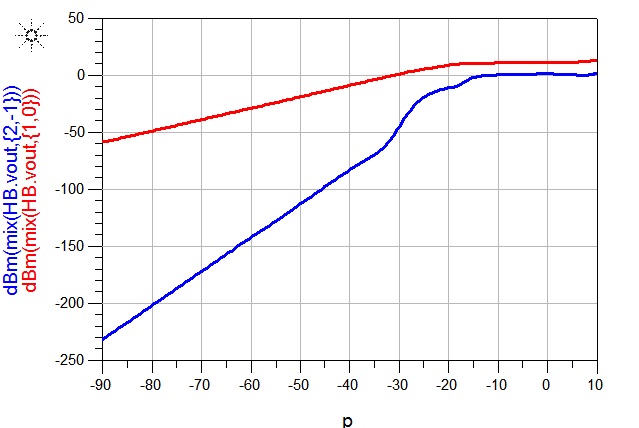Two IP3 related question
I've got two questions about measuring IIP3
here is first: in the picture I attached you can see IMD3 products start to increase insanely at -33dBm hence IP3 gets much worth! So does it mean that I should only use this LNA for input power less than -33dBm?

2'nd: the following picture shows the higher and lower IMD3 products of a mixer in a two-tone test. But they are not equal. Why? then how should I measure the IIP3?
*I measured IIP3 based on the one that does not change significantly by variations of the input power(or the one that is more likely to be IIP3).

It depends on application of your LNA.
For example, you can use input power at almost 1dB gain compression point, if your LNA application is narrowband and there is no adjacent channel.
It could be frequency characteristics.
Show me followings.
(1) Frequency of RF1 and RF2
(2) Local Frequency
(3) Frequency of IF1 and IF2.
Show me over plot of Upper and Lower.
my standard is IEEE802.15.4 with 0dB rejection for adjacent channel and 30dB rejection for alternate channel. But I don't follow how these are related and why exactly!
here is all info:
Harmonic Balance input frequencies:
Freq[1]=2441 MHz (upper fundamental)
Freq[2]=2439 MHz (Lower fundamental)
Freq[3]=2436 MHz (Local oscillator)
I swept both input RF tones together and equally but surprisingly fundamentals at the output are not the same(figure 1)! but then when they mix with LO they become equal(figure2)!
and about intermodulation products:
Upper IMD3=2*2441-2439=2443 MHz After mixing(IF IMD)=7 MHz
Lower IMD3=2*2439-2441=2437 MHz After mixing(IF IMD)=1 MHz
(figure3 shows IM products at RF and figure4 shows them at IF)
Why they are not equal!?
Note:
1- I tried smaller fundamental spacings: (upper=2440.01MHz) and (lower=2439.99MHz). No change!
2- I checked the input P_ntone source.
3- It's just a regular single Balanced but I got the same issue for other works

Local frequency has to be Freq[1] in Keysight ADSsim.
Show me netlist regarding HB Analysis settings.
I want to know order and maxorder.
Try followings as Test.
Freq[1]=2436 MHz (Local oscillator)
Freq[2]=2436.10 MHz (Lower fundamental)
Freq[3]=2436.15 MHz (Upper fundamental)
This was the problem, I defined LO frequency as first in HB palette and everything is right now.
Thank you "pancho_hideboo".
and now for the first question, I would be appreciated if you explain it or give me a reference.
Multitone HB Analysis is based on aperiodic function expansion.
Formulation of Keysight ADSsim uses Freq[1] as special meaning.
This is dragging from MDS which is ancestor of ADS.
See documents on HB Analysis of ADSsim.
On the other hand, there is no difference about treatmeant regarding Freq[1], Freq[2] and Freq[3] in Keysight Goldengate Simulator.
ADS documents are huge, and it takes time to read them!
I don't have access to GoldenGate simulator so its just ADS :(
Anyway, Thank you for your help and support, I'm doing my thesis so I'll be around for a while :)
